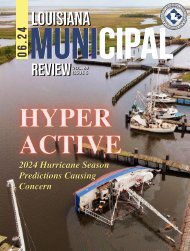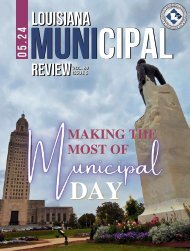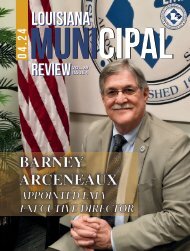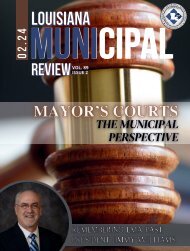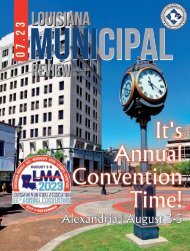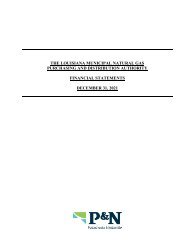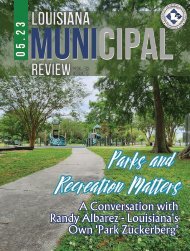October 2023
Create successful ePaper yourself
Turn your PDF publications into a flip-book with our unique Google optimized e-Paper software.
ecause of how it all works together. All<br />
of the factors combined treat the wind<br />
as a sort of fuel. I saw a fire run up a tree<br />
and ignite a limb. Those embers were<br />
then blown by the wind. That caused<br />
the creation of another hotspot. Our<br />
pine trees are dropping needles due to<br />
the lack of water, which causes their sap<br />
to serve as a sort of kerosene in the heat<br />
and dry conditions. Embers only have to<br />
travel yards, not miles, to start another<br />
fire. Before fire trucks can get there, they<br />
become one-acre fires, and the firefighters<br />
have to start all over again. So, you’ve<br />
got a situation that’s incredibly unusual.<br />
The dryness we’re experiencing<br />
is going to get worse, as there’s<br />
no significant rain in the forecast,<br />
which is one thing<br />
that would really turn this<br />
around.”<br />
Commissioner of Insurance<br />
Jim Donelon understands<br />
that numerous<br />
insurance claims<br />
are set to come to light<br />
and reminds municipal<br />
leaders of steps they<br />
can take to make sure<br />
their municipalities don’t<br />
get caught in a never-ending<br />
loop of denials.<br />
“Municipalities should review<br />
their respective property policies<br />
to determine if a wildfire is a<br />
covered peril,” said Donelon. “From<br />
a liability insurance perspective, municipalities<br />
should further<br />
review<br />
their liability<br />
policy to<br />
determine if<br />
something<br />
may cause a<br />
wildfire and<br />
be a covered<br />
peril. This is<br />
important<br />
Jim Donelon to know because,<br />
for example, a public project such<br />
as electrical infrastructure work that is<br />
undertaken during an extremely dry<br />
season could spark a fire that spreads<br />
throughout a community. I also strongly<br />
encourage municipalities to remind<br />
their residents to review their personal<br />
and commercial insurance policies as<br />
well.”<br />
Not enough wildfire training on the part<br />
of volunteer fire departments specifically,<br />
and not enough public outreach on<br />
the devastating impacts that wildfire<br />
season can have, are also key components.<br />
And yes - Louisiana has a wildfire<br />
season, but it’s not something Louisianans<br />
hear much about.<br />
Wildfire season in Louisiana peaks in<br />
early September and runs for 30 weeks,<br />
taking the state into the end of March.<br />
Let’s look closely at the start date – the<br />
beginning of September. We’ve already<br />
seen over<br />
60,000 acres<br />
lost, with<br />
much of that<br />
loss taking<br />
place before<br />
the official<br />
wildfire peak<br />
season. And<br />
the length<br />
of time is<br />
important Butch Browning<br />
to note. If<br />
something runs for 30 weeks, should it<br />
lose its seasonal status? With something<br />
that can cause devastation<br />
for a majority of a calendar year<br />
starting even earlier than expected,<br />
why isn’t wildfire<br />
season more notable and<br />
year-round? And why aren’t<br />
we more aware? Former<br />
State Fire Marshal<br />
Butch Browning has<br />
some thoughts on that.<br />
“Wildland fires have<br />
been a common part of<br />
our fire threat for ages,<br />
and the methods to control<br />
them are much different<br />
than the conventional<br />
municipal fire departments<br />
are equipped and trained to<br />
do. When fire gets near inhabited<br />
areas it is called the ‘interface,’<br />
and it is where your local fire department<br />
would be called to control and<br />
mitigate before structures and people<br />
are in danger. The key to prevention is<br />
limiting the vegetation and combustibles<br />
near your home (this includes a 10-<br />
foot space around your home), having<br />
screens that keep embers from blowing<br />
under patios and carports, and keeping<br />
gutters clean. When there is a threat, one<br />
can water lawns and soak rooftops in an<br />
effort to extinguish embers. We understand<br />
that dry conditions make wildland<br />
fires more frequent, but the factor that<br />
will quickly incapacitate firefighting ef-<br />
LMR | OCTOBER <strong>2023</strong> Page 9




